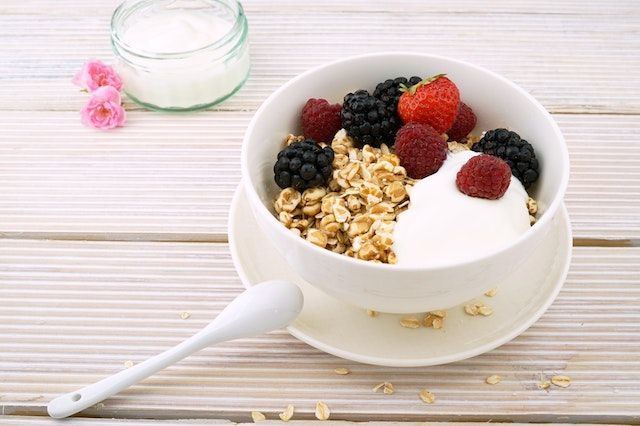A Journey to a Healthier Gut and Mood (Recipes Included!)
Introduction
Welcome to a journey that takes us deep into the heart of our kitchens, exploring a culinary tradition that's been around for centuries but is gaining newfound popularity in today's health-conscious world: fermented foods. In this episode/blog post, we're going to unlock the power of fermented foods and discover how they can play a pivotal role in improving your gut health and mood.
Fermented foods might sound mysterious, but they've been a part of human culture and cuisine for generations. From the tangy zest of sauerkraut to the effervescent delight of kombucha, these foods have been cherished not only for their unique flavors but also for their incredible health benefits.
In a world where our diet plays an increasingly central role in our overall well-being, it's no wonder that the spotlight is now on fermented foods. Today, we'll delve into what makes these foods so special, why they've been created for centuries, and how they can transform your health for the better.
But it's not all sunshine and rainbows – as with any dietary trend, there are nuances and potential pitfalls to be aware of. So, we'll also explore some of the health concerns associated with overindulging in fermented foods.
So, whether you're a seasoned fermenter or you're just starting to explore this flavorful world, stick with us as we uncover the pros and cons of fermented foods and learn how they can make a profound difference in your gut health and even your mood.
Let's embark on this fascinating journey into the world of fermented foods and discover how they can enrich our lives.
What Are Fermented Foods?
Fermented foods are nature's probiotics, deliciously transformed through a time-honored process of microbial magic. At their core, fermented foods are ingredients that have undergone fermentation, a natural process where beneficial microorganisms such as bacteria or yeast break down the components of the food. This transformation not only enhances their flavors and textures but also provides a myriad of health benefits.
Examples of Fermented Foods:
· Yogurt: Creamy and tangy, yogurt is perhaps one of the most well-known fermented foods. It starts as milk, which is fermented by lactic acid bacteria, resulting in a thick, probiotic-rich treat.
· Sauerkraut: Hailing from Germany, sauerkraut is fermented cabbage, often flavored with caraway seeds or other spices. It's celebrated for its sour and crunchy qualities.
· Kombucha: This effervescent tea drink is created by fermenting sweetened tea with a culture known as a SCOBY (Symbiotic Culture of Bacteria and Yeast). Kombucha offers a delightful combination of sweetness and tartness.
· Kimchi: A staple of Korean cuisine, kimchi is a spicy and savory dish made from fermented vegetables, primarily cabbage and radishes, seasoned with garlic, ginger, and red pepper flakes.
These are just a few examples, as there's a vast array of fermented foods from different cultures around the world, each offering a unique taste and nutritional profile.
The Fermentation Process
Fermentation is the magical transformation that takes place when microbes feast on the sugars and starches present in the food. During this process, they convert these components into various compounds, including organic acids, gases, and alcohol, depending on the type of fermentation.
Types of Fermentation:
· Lactic acid
· Ethyl Alcohol
· Acetic Acid
The key to fermentation is creating the right environment for the desired microorganisms to thrive. This typically involves controlling factors like temperature, moisture, and time. The end result? Foods that are not only flavorful but also teeming with beneficial probiotics.
The probiotics found in fermented foods are living microorganisms that can positively influence your gut health when consumed. They help maintain a balanced and diverse gut microbiome, which is crucial for overall well-being.
Why Were Fermented Foods Created?
Fermented foods have a rich and storied history that spans across cultures and centuries. These age-old creations weren't just born out of culinary curiosity; they served practical purposes that have stood the test of time. Let's delve into the compelling reasons why fermented foods have been crafted throughout history:
1. Preservation: Long before refrigeration and modern food preservation techniques, fermentation was a reliable method to extend the shelf life of perishable ingredients. By harnessing the power of beneficial microorganisms, communities could enjoy the harvest's bounty well beyond its seasonal peak. Sauerkraut, for example, was originally developed as a way to preserve cabbage through the harsh European winters.
2. Enhanced Flavor and Texture: Fermentation isn't just about preservation; it's also about transformation. The process of fermentation can profoundly alter the taste and texture of foods. For instance, the fermentation of soybeans gives rise to soy sauce, an umami-rich condiment that's a staple in Asian cuisine. The marriage of flavors and the development of complex aromas make fermented foods a culinary adventure.
3. Nutrient Enhancement: Fermentation can significantly enhance the nutritional value of foods. During the process, microorganisms break down complex molecules, making nutrients more accessible and digestible. This not only increases the bioavailability of essential vitamins and minerals but also creates new bioactive compounds. In the case of fermented dairy products like yogurt, lactose (milk sugar) is converted into lactic acid, making it easier to digest for individuals with lactose intolerance.
4. Tradition and Culture: Fermented foods are often deeply intertwined with cultural identities and traditions. Every region has its own signature fermented dishes, passed down through generations. These foods play a vital role in culinary heritage and celebrations. Kimchi, for example, is an integral part of Korean cuisine and culture, enjoyed in countless variations and forms.
5. Holistic Health: Historically, many cultures believed that fermented foods had health-promoting properties. While this wisdom preceded our modern understanding of probiotics and gut health, it's worth noting that the connection between fermented foods and well-being has been recognized for centuries.
In today's world, where food preservation and flavor enhancement are no longer the primary drivers, the health benefits of fermented foods have taken center stage.
Health Benefits of Fermented Foods
Fermented foods are more than just delectable additions to your plate; they're nutritional powerhouses that can positively impact your overall health and well-being. Here's a closer look at the remarkable health benefits of including fermented foods in your diet:
1. Improved Digestion: Fermented foods are a boon for your digestive system. The beneficial microorganisms in these foods, such as probiotics, help maintain a balanced gut microbiome. They break down complex carbohydrates and support the digestion and absorption of nutrients, promoting a healthy gut.
2. Enhanced Nutrient Absorption: The fermentation process increases the bioavailability of nutrients in foods. For instance, the transformation of soybeans into miso or tempeh makes essential minerals like iron and zinc more easily absorbable. This means you get more nutritional bang for your buck when you consume fermented foods.
3. Reduced Inflammation: A balanced gut microbiome can help regulate inflammation in the body. Chronic inflammation is associated with various health issues, including autoimmune diseases and metabolic disorders. By promoting gut health, fermented foods may contribute to lowering inflammation levels.
4. Immune System Support: Your gut is a crucial hub for immune system activity, and a well-balanced microbiome is essential for its proper function. Probiotics found in fermented foods can stimulate immune cells, enhancing your body's defense mechanisms against infections and illnesses.
5. Mood and Mental Health: Emerging research suggests a strong connection between gut health and mood. The gut-brain axis, a bidirectional communication system between the gut and the brain, plays a significant role in regulating mood and emotions. Fermented foods may contribute to better mental well-being by positively influencing this axis.
6. Weight Management: A balanced gut microbiome is linked to weight regulation. Some studies suggest that certain probiotics found in fermented foods could aid in weight loss and weight maintenance by helping to control appetite and reduce fat storage.
7. Heart Health: Regular consumption of fermented foods may have a positive impact on heart health. Some fermented foods, like kefir, have been associated with reduced cholesterol levels, which can lower the risk of heart disease.
8. Allergen Reduction: The fermentation process can break down allergenic compounds in foods. For instance, people with lactose intolerance may find that fermented dairy products, like yogurt, are more tolerable due to the reduced lactose content.
9. Maintenance of Intestinal Integrity: Fermented foods can help maintain the integrity of the intestinal lining. This is crucial for preventing "leaky gut" syndrome, a condition where the gut barrier becomes compromised, potentially leading to various health issues.
10. Diverse Microbiome: Variety is key to a healthy gut microbiome. Consuming a range of fermented foods introduces different strains of beneficial bacteria into your gut, promoting diversity and resilience in your microbial ecosystem.
Specific Health Benefits
Fermented foods are like nutritional superheroes, each with its own unique powers to support your health and well-being. In this section, we'll delve into the specific health benefits that different types of fermented foods offer:
1. Yogurt for Gut Health:
· Probiotic Power: Yogurt is perhaps the most famous probiotic-rich food. It's packed with live bacteria like Lactobacillus and Bifidobacterium, which can enhance gut health.
· Digestive Ease: For those with lactose intolerance, yogurt is often better tolerated due to the conversion of lactose into lactic acid during fermentation.
· Immune Support: The probiotics in yogurt may strengthen the immune system and help ward off infections.
2. Sauerkraut for Digestion:
· Fiber-Rich: Sauerkraut is an excellent source of dietary fiber, which supports regular bowel movements and aids in digestion.
· Probiotic Punch: Its fermentation process introduces beneficial bacteria that promote a balanced gut microbiome.
· Vitamin C Boost: Sauerkraut is also rich in vitamin C, an antioxidant that supports immune function and collagen production.
3. Kombucha for Detoxification:
· Liver Support: Kombucha contains glucuronic acid, which may assist in the body's natural detoxification processes.
· Antioxidant Arsenal: The tea used to make kombucha provides antioxidants that combat free radicals and reduce oxidative stress.
· Joint Health: Some kombucha variations contain glucosamine, which supports joint health and may alleviate arthritis symptoms.
4. Kimchi for Immunity and Weight Management:
· Spicy Probiotics: Kimchi's spicy kick comes from red pepper flakes, which contain capsaicin—a compound that may boost metabolism.
· Vitamin-Rich: Kimchi is a good source of vitamins A, C, and K, as well as essential minerals like calcium and iron.
· Gut Harmony: The probiotics in kimchi promote gut health and may help regulate the immune system.
5. Miso and Tempeh for Protein and Nutrient Boost:
· Plant-Based Protein: Miso and tempeh are plant-based protein sources, ideal for vegetarians and vegans.
· Vitamin Bounty: These fermented soy products are rich in B vitamins, including B12, which is often lacking in plant-based diets.
· Bone Health: Miso contains vitamin K2, which plays a role in bone health and calcium metabolism.
6. Fermented Dairy Products for Bone Health:
· Calcium and More: Fermented dairy products like kefir and some yogurts provide calcium, magnesium, and vitamin D, promoting bone health.
· Digestive Aid: The probiotics in these products can aid digestion and alleviate gastrointestinal discomfort.
By incorporating a variety of these fermented foods into your diet, you can enjoy a diverse range of health benefits, from improved digestion and immune support to potential weight management and mood enhancement.
Enjoying Fermented Foods
Now that we've explored the enticing world of fermented foods and their myriad health benefits, it's time to embrace these culinary treasures in your daily life. Whether you're a seasoned fan or a newbie, here are some tips for incorporating and enjoying fermented foods:
1. Start Slowly:
· If you're new to fermented foods, start with small servings to allow your gut to adjust gradually.
· Introduce one type of fermented food at a time to determine your preferences.
2. Variety is Key:
· Incorporate a diverse range of fermented foods into your diet to maximize the benefits of different probiotic strains.
· Explore global cuisines to discover unique fermented delicacies from various cultures.
3. Mix and Match:
· Get creative by combining fermented foods with other dishes. For example, add sauerkraut to your sandwiches or top your morning cereal with yogurt.
4. Snack Smart:
· Fermented foods make for excellent snacks. Choose probiotic-rich yogurt, kefir smoothies, or kimchi as tasty and nutritious between-meal options.
5. Homemade Fermentation:
· Consider making your own fermented foods at home. It's a fun and rewarding way to experiment with flavors and ingredients.
· Experiment with homemade kombucha, sauerkraut, kimchi, or yogurt using the DIY recipes below.
6. Culinary Creativity:
· Use fermented foods as flavor enhancers in your cooking. Kimchi, for instance, can add a spicy kick to stir-fries or rice dishes.
· Try incorporating kefir into salad dressings or smoothie bowls for added creaminess and probiotics.
7. Mindful Pairing:
· Pair fermented foods with complementary dishes. For instance, a dollop of yogurt complements spicy Indian curries, while sauerkraut pairs well with sausages.
8. Explore the Market:
· Visit local farmers' markets or specialty stores to discover artisanal and unique fermented products.
· Look for unpasteurized or raw versions of fermented foods for maximum probiotic benefits.
9. Read Labels:
· When purchasing store-bought fermented foods, read labels carefully. Opt for products with live active cultures and minimal additives or preservatives.
10. Listen to Your Body:
· Pay attention to how your body responds to fermented foods. While they offer numerous benefits, everyone's digestive system is unique. If you experience discomfort, adjust your consumption accordingly.
Remember that the key to reaping the full benefits of fermented foods is consistency. Make them a regular part of your diet to support your gut health and overall well-being. Whether enjoyed as a snack, incorporated into meals, or experimented with in your own kitchen, fermented foods can add a delicious and nutritious dimension to your culinary journey.
Fermented Foods & SIBO
Fermented foods may not be for everyone. Small Intestinal Bacterial Overgrowth (SIBO) is a condition characterized by the excessive growth of bacteria in the small intestine, which can lead to various digestive symptoms. Whether or not fermented foods negatively affect SIBO can depend on the individual and the specific circumstances of their condition. Here are some considerations:
1. Fermented Foods and SIBO:
· Fermented foods are known to contain beneficial probiotics that support gut health. In some cases, consuming probiotics from fermented foods might help improve the balance of bacteria in the gut.
· However, for individuals with SIBO, the issue is an overgrowth of bacteria, and introducing more bacteria through fermented foods may not be the best approach.
2. Individual Variation:
· Responses to fermented foods can vary significantly among individuals with SIBO. Some may tolerate certain fermented foods well, while others might experience worsening symptoms.
· It's crucial to pay attention to your body's response and work with a healthcare provider or dietitian to tailor your diet to your specific needs.
3. Low-FODMAP Fermented Foods:
· Fermented foods can be high in FODMAPs (fermentable oligosaccharides, disaccharides, monosaccharides, and polyols), which can exacerbate symptoms in some people with SIBO.
· Low-FODMAP versions of fermented foods, such as lactose-free yogurt or fermented vegetables made without high-FODMAP ingredients, may be better tolerated.
4. Gradual Introduction:
· If you want to incorporate fermented foods into your diet while managing SIBO, it's essential to do so gradually, start with small amounts and monitor how your body responds.
5. Seek Professional Guidance:
· If you have SIBO or suspect you may have it, it's crucial to work closely with a functional nutritionist who specializes in gastrointestinal disorders. In my opinion, care should always be to identify the help of the gut and any food sensitivities that my lead to a leaky gut and more systemic problems.
The impact of fermented foods on individuals with SIBO can vary widely. While some may benefit from the probiotics in fermented foods, others may find that these foods exacerbate their symptoms. It's essential to approach fermented foods with caution, pay attention to your body's response, and seek professional guidance to determine the best dietary approach for managing SIBO.
DIY At-Home Fermentation Recipes
There's something deeply satisfying about crafting your own fermented foods at home. It allows you to control the ingredients, flavors, and fermentation process, resulting in delicious and personalized creations. Let's dive into some DIY recipes for three popular fermented foods: homemade kombucha, sauerkraut, and dairy-free yogurt.
Homemade Kombucha
Kombucha is a fizzy, slightly tangy tea drink that owes its charm to fermentation. Here's how to make it at home:
Ingredients:
· 4-6 bags of black or green tea
· 1 cup of white sugar
· SCOBY (Symbiotic Culture of Bacteria and Yeast)
· 1-2 cups of starter tea (from a previous batch or store-bought kombucha)
Instructions:
1. Boil 4 cups of water and steep the tea bags for about 10-15 minutes.
2. Stir in the sugar until it dissolves, then let the tea cool to room temperature.
3. Transfer the sweetened tea to a large glass jar, leaving some space at the top.
4. Add the SCOBY and starter tea.
5. Cover the jar with a clean cloth or paper towel secured with a rubber band.
6. Place the jar in a warm, dark place for 7-14 days, depending on your preferred taste.
7. Taste the kombucha periodically until it reaches your desired level of tanginess.
8. Once ready, remove the SCOBY and reserve some of the liquid as starter for your next batch.
9. Bottle the kombucha in airtight containers, adding flavorings like fruit or ginger if desired.
10. Seal the bottles and let them sit at room temperature for an additional 2-5 days to carbonate.
11. Refrigerate your homemade kombucha, and enjoy it cold!
DIY Sauerkraut
Sauerkraut is a delightful fermented cabbage dish with a crisp texture and tangy flavor. Here's how to make it:
Ingredients:
· 1 medium cabbage (about 2-2.5 pounds)
· 1.5 tablespoons of salt (non-iodized)
· Optional: caraway seeds, juniper berries, or other spices for flavor
Instructions:
1. Shred the cabbage finely and place it in a large bowl.
2. Sprinkle the salt over the cabbage and start massaging it with your hands. This process will release moisture from the cabbage.
3. Continue massaging for about 5-10 minutes until the cabbage becomes limp and releases enough liquid to submerge itself.
4. Add any optional spices or flavorings and mix them into the cabbage.
5. Pack the cabbage mixture tightly into a clean glass jar, pressing it down to ensure there are no air pockets.
6. The liquid should cover the cabbage. If not, add a bit of brine (1 teaspoon of salt dissolved in 1 cup of water) to cover the cabbage completely.
7. Place a weight on top of the cabbage to keep it submerged. You can use a clean, heavy object or a smaller jar filled with water.
8. Cover the jar with a clean cloth or paper towel secured with a rubber band.
9. Allow the sauerkraut to ferment at room temperature for 1-2 weeks or longer, depending on your taste preferences.
10. Once it reaches your desired level of tanginess, remove the weight and cover with a lid. Refrigerate your sauerkraut for long-term storage.
Dairy-Free Yogurt
For those seeking a dairy-free alternative, making dairy-free yogurt at home is a delicious option. Here's a simple recipe using coconut milk:
Ingredients:
· 2 cans (800ml) of full-fat coconut milk
· 2 tablespoons of dairy-free yogurt with live cultures (as a starter)
· Optional sweeteners or flavorings like vanilla extract or honey
Instructions:
1. Pour the coconut milk into a saucepan and gently heat it to about 110°F (43°C), using a thermometer to monitor the temperature.
2. Remove from heat and let it cool to around 110°F (43°C).
3. In a separate bowl, mix the dairy-free yogurt starter with a small amount of the warm coconut milk to create a smooth paste.
4. Add the paste back into the remaining coconut milk and stir well.
5. Transfer the mixture into clean glass jars or containers.
6. Cover the jars with lids or plastic wrap.
7. Place the jars in a warm, dark place to ferment. You can use a yogurt maker or an oven with the light on to maintain the temperature at around 110°F (43°C).
8. Allow the yogurt to ferment for 8-12 hours, depending on your desired thickness and tanginess.
9. Once the yogurt reaches the desired consistency, refrigerate it to stop the fermentation process.
10. Before serving, you can add sweeteners, fruit, or flavorings to taste.
Homemade Kimchi Recipe
Ingredients:
For the Vegetables:
· 1 medium Napa cabbage (about 2 pounds)
· 1/4 cup kosher salt
For the Kimchi Paste:
· 1/4 cup Korean red pepper flakes (gochugaru) - adjust for desired spice level
· 1 tablespoon sugar
· 1 teaspoon minced fresh ginger
· 1 teaspoon minced garlic
· 2 tablespoons fish sauce (for a vegetarian version, use soy sauce or tamari)
· 2 tablespoons shrimp paste (optional, for a vegetarian version, omit or use miso paste)
· 2 green onions, chopped
· 1 small carrot, julienned
· 1/2 daikon radish, julienned (optional)
Instructions:
1. Prepare the Cabbage:
· Cut the Napa cabbage into quarters lengthwise.
· Remove the core from each quarter and chop the cabbage into bite-sized pieces.
· Place the chopped cabbage in a large bowl.
2. Salt and Soak:
· Sprinkle the kosher salt over the cabbage.
· Massage the salt into the cabbage, ensuring it's evenly distributed.
· Add enough water to cover the cabbage, and then place a heavy plate or a bowl on top to weigh it down.
· Let the cabbage sit for 1-2 hours, turning it occasionally. This will help draw out excess moisture.
3. Rinse and Drain:
· After 1-2 hours, the cabbage should be softened and wilted.
· Rinse the cabbage thoroughly under cold running water to remove excess salt.
· Drain the cabbage well in a colander, squeezing gently to remove excess water.
4. Prepare the Kimchi Paste:
· In a mixing bowl, combine the Korean red pepper flakes (adjust the quantity based on your spice preference), sugar, minced ginger, minced garlic, fish sauce (or soy sauce/tamari for a vegetarian version), and shrimp paste (if using).
· Mix the ingredients into a smooth paste. If the paste is too thick, you can add a tablespoon or two of water to thin it out.
5. Combine Cabbage and Paste:
· In a large mixing bowl, combine the drained cabbage, green onions, carrot, and daikon radish (if using).
· Wear disposable gloves (or use a spoon) to mix the kimchi paste thoroughly with the vegetables. Make sure all the vegetables are well-coated with the paste.
6. Pack into Jars:
· Transfer the kimchi mixture into clean glass jars or airtight containers.
· Press down on the kimchi as you pack it into the jars, removing any air bubbles.
· Leave some space at the top of the jars as kimchi can expand during fermentation.
7. Ferment:
· Seal the jars or containers and let the kimchi ferment at room temperature for 1-5 days. The fermentation time depends on your taste preference; shorter for milder kimchi and longer for a stronger, tangier flavor.
· Open the jars daily to release any gas buildup and press the kimchi down to submerge it in its juices.
8. Refrigerate:
· Once the kimchi reaches your desired level of fermentation, move it to the refrigerator.
· It can be enjoyed immediately, but its flavor will continue to develop over time.
Homemade kimchi is a versatile condiment that can be enjoyed on its own, in salads, rice bowls, or as a side dish to complement a variety of meals. Remember to store it in the refrigerator to slow down the fermentation process and keep it fresh for an extended period. Enjoy the spicy, tangy, and probiotic-rich goodness of your homemade kimchi!
Health Concerns and Pitfalls of Fermented Foods
While fermented foods offer numerous health benefits, it's essential to approach them with a balanced perspective. Here are some potential health concerns and pitfalls associated with fermented foods:
1. Sodium Content:
· Some fermented foods, such as sauerkraut and pickles, can be high in sodium due to the salt used in the fermentation process.
2. Sugar Content:
· Certain commercially-produced fermented foods, like flavored yogurts or kombucha, may contain added sugars to enhance taste.
· Excess sugar consumption can lead to weight gain, dental problems, and other health issues.
3. Lactose and Dairy Allergies:
· Fermented dairy products like yogurt can still contain lactose, which may not be suitable for individuals with lactose intolerance.
· While some fermentation processes break down lactose, it's essential to check labels for lactose-free options or explore non-dairy alternatives like coconut or cashew yogurt.
5. Histamine Intolerance:
· Fermentation can produce histamines, naturally occurring compounds in the body that play a role in allergic reactions.
· Some individuals may be sensitive to histamines and experience symptoms like headaches, skin rashes, or digestive discomfort when consuming histamine-rich fermented foods like aged cheeses or certain wines.
6. Overconsumption:
· While fermented foods offer health benefits, excessive consumption can lead to gastrointestinal discomfort, including gas and bloating.
· It's essential to incorporate fermented foods into your diet gradually, allowing your gut to adjust.
7. Individual Sensitivities: - Fermented foods contain live microorganisms, and some individuals may have sensitivities or allergies to specific strains. While fermented foods offer a myriad of health benefits, it's essential to enjoy them mindfully and in moderation, taking into consideration any specific dietary restrictions or sensitivities you may have.
In Conclusion: Embracing Fermented Foods for a Healthier You
In our exploration of the world of fermented foods, we've uncovered a universe of flavors, traditions, and health benefits that have been cherished for generations. From the tangy allure of sauerkraut to the effervescent delight of kombucha, fermented foods have earned their place on our plates for good reason.
Fermentation, a timeless culinary art, not only tantalizes our taste buds but also enriches our well-being in numerous ways. These probiotic powerhouses support our digestive health, enhance nutrient absorption, and even have the potential to elevate our mood. They are culinary creations that bridge cultures and traditions, a testament to the beauty of food as a unifying force.
Yet, as with any dietary trend, there are nuances to consider. We've explored the potential pitfalls of fermented foods, from their sodium and sugar content to considerations for specific health conditions like SIBO.
Incorporating fermented foods into your diet can be a delicious and transformative journey. Whether you're crafting your own kombucha or savoring the complexity of homemade kimchi, these creations offer a personalized touch to your culinary repertoire.
Remember that balance is key, especially if you have specific health concerns or dietary restrictions.
As you embrace the world of fermented foods, may your culinary adventures be richly rewarding, your gut health thrive, and your mood uplifted. These age-old treasures are not just about what's on your plate; they're about nourishing your body, connecting with tradition, and embarking on a flavorful journey to a healthier you.












